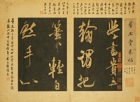Asian Gallery (Toyokan) Room 8
April 17, 2007 (Tue) - July 1, 2007 (Sun)
During the Taisho (1912-1926) and early Showa (1926-1989) periods, when tea lovers enthusiastically collected rare and exquisite art works used for the tea ceremony, others, such as Takashima Kikujiro (1875-1969), were passionate about Chinese culture and endeavored to collect Chinese works of art. An active industrialist, Mr. Takashima also had deep knowledge of Chinese studies and language, and collected Chinese old paintings, calligraphy, and rubbings. His collection has been featured in various publications and admired by researchers and art lovers both in and outside Japan.
With the opening of the Toyokan (Asian Gallery) a few years ahead, Mr. Takashima kindly donated his collection to the Tokyo National Museum in the spring of 1965. The more than 300 works included in the collection have always supported the display of Chinese painting and calligraphy in the Toyokan gallery, provided pleasure to art lovers, and served as valuable materials for researchers.
The present exhibition is part of a joint project with the Mitsui Memorial Museum and the Taito City Calligraphy Museum to show the collections simultaneously. Unlike later products, Song dynasty ink had elegant blue tint, with which rubbings were made in a variety of styles. The subtle differences of ink shades, as well as sharp and three-dimensional outlines provide rubbings a quality unique and beyond mere prints and different from that of free hand writings. The display also includes Qing dynasty calligraphic works to show influences of rubbings. We hope that visitors enjoy the mysterious shades of ink of ancient rubbings and the feel of stones.

